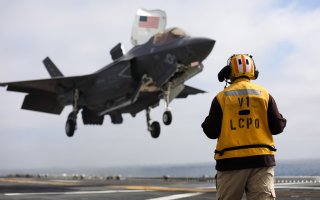31 Pilots Explain Why They Love the F-35 (More Than Any Other Aircraft)
Coupled with stealth, this jet is all but invisible to enemy radars.
Here's What You Need to Know: The F-35 continues to attract high praise.
Hundreds of U.S. pilots currently have been trained to fly Lockheed Martin’s F-35A Lightning II. A few years back, the Heritage Foundation interviewed 31 of these former F-15C, F-15E, F-16C, and A-10 pilots. Each expressed a high degree of confidence in the F-35A, their new fifth-generation platform.
Here are nine insights gleaned from those conversations:
1. Even with developmental restrictions that limit the F-35A’s responsiveness and ability to maneuver, every U.S. fighter pilot interviewed would pick the F-35A over his former jet in a majority of air-to-air (dogfight) engagement scenarios they could face.
2. A former F-15C instructor pilot said he consistently beat his former jet in mock dogfights.
3. A former F-16C instructor—and graduate of the Air Force Weapons Instructor Course (Which is similar to the Navy's famed “Top Gun” school)—said the jet is constrained on how tight it can turn (G-limited) now. But even so, the rudder-assisted turns are incredible and deliver a constant 28 degrees of turn a second. When the Air Force removes the restrictions, this jet will be eye watering.
4. Three former F-16CJ Wild Weasel instructor pilots, those tasked with attacking surface-to-air missile sites, said a single F-35A can find and attack SAM sites faster and more effectively than three F-16CJ fighters working together.
5. The F-35A’s radar effectively can shut down enemy fighter and surface-to-air radars without those adversaries becoming aware they are being electronically attacked. Coupled with stealth, this jet is all but invisible to enemy radars.
6. A former A-10 instructor pilot said the situational awareness aids associated with the sensor suite of the F-35A allowed pilots to execute close air support missions as well or better than the A-10 in low-threat environments. The F-35A is the only multirole platform capable of conducting close air support in high-threat environments.
7. The research and development that went into the stealth skin of the F-35A removed the high-maintenance and sortie-limiting requirements associated with the radar-absorbing skin of the F-22, F117, or B-2. Stealth does not limit the F-35A’s ability to fly multiple combat or training sorties each day.
8. Bringing all the tactical sensors of the F-35A into a single display (sensor fusion) is still not optimized, and most pilots complained of “ghosts” or multiple displayed contacts for the same threat.
9. In full production, the F-35A is projected to cost less than the four-plus generation Eurofighter Typhoon, the French Rafale M, or the latest version of the F-15K Strike Eagle. It will outperform those jets and every other four-plus generation fighter in an air-to-surface role, and none of them would fare well against it in an air-to-air engagement.
Concurrent development of the F-35A certainly has had its challenges, and the risks for delays and cost overruns should have been factored into the acquisition process. They were not.
Component, sensor, and airframe development were (and still are) all happening at the same time, and even small changes in the weight, size, performance, and schedule of any component could affect the weight, size, performance, and schedule of the entire system.
The biggest single factor in keeping the program on time and under budget is effective, stable leadership. That leadership is now in place and the United States is on the precipice of delivering arguably the freshest, most advanced fighter technology ever fielded.
The gains and contracting lessons gleaned through concurrent development of the F-35A program are significant. The Pentagon needs to apply them to every major acquisition program for technology and systems that are susceptible to fielding obsolescence.
This piece first appeared in 2016 in The Daily Signal here.
Image: Flickr / U.S. Navy

